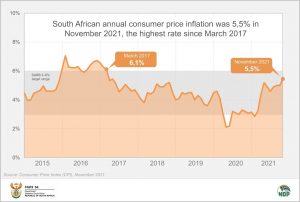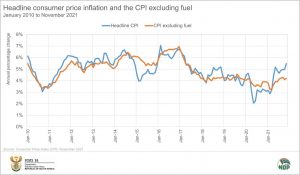Consumer inflation the highest since March 2017
Annual consumer inflation accelerated to its highest reading in more than four-and-a-half years in November, driven mostly by rising transport costs. The annual change in the consumer price index (CPI) was 5,5%, up from 5,0% in October and September. This is the biggest annual increase since March 2017 when the rate was 6,1%.
The monthly change in November 2021 was 0,5%.
Transport prices drive inflation higher
The transport category continues to be the major factor behind inflation, recording an annual increase of 15,0% in November. This makes it the only major group in the inflation basket with an annual rate above the 6,0% upper limit of the South African Reserve Bank’s monetary policy target range. The transport category was the only contributor to the monthly increase in the CPI and was the largest factor driving the annual change in the index, contributing 2,1 percentage points to the 5,5% annual inflation rate.
Fuel prices increased by 7,1% between October and November, taking the annual rate to 34,5%. The price of inland 95-octane petrol was R19,54 per litre in November 2021 compared with R14,59 in November 2020.1 The diesel index increased by 35,1% over the same period. The average price of diesel was R18,75 per litre in November 2021 compared with R13,89 per litre in November 2020.
To highlight the impact of fuel prices, the chart below is from a recent Stats SA article on the breakdown of the fuel price2, updated with data for October and November 2021. The CPI excluding fuel line shows what overall inflation would be if the influence of fuel was removed. Those periods where headline CPI does not closely follow the CPI excluding fuel indicate a noticeable impact of changing fuel prices on overall inflation.
In 2021, headline inflation was mostly higher than the CPI excluding fuel, indicating the impact of rapidly rising fuel prices. In November, the annual change in the CPI excluding fuel index was 4,2%, lower than the headline rate of 5,5%.
Public transport tariffs recorded a monthly increase of 1,7% and an annual rise of 8,3%. On average, vehicles are 5,6% more expensive than they were in November 2020.
Food inflation slows in November
Prices for food and non-alcoholic beverages recorded an annual increase of 5,5% and a monthly rise of 0,1%. The annual increase is the lowest in 9 months – since February 2021 when the rate was 5,2%.
Bread and cereal products recorded above average price increases of 0,5% between October and November. White bread prices increased by 1,2% and brown bread by 1,4% in this period.
Meat inflation slowed for the third consecutive month, recording an annual rise of 8,5%, down from 10,7% recorded in August 2021. Chicken and beef products registered the largest annual increases in November. Price increases were recorded for IQF chicken portions (up 13,7%), chicken giblets (up 7,7%), beef offal (up 14,6%) and beef mince (up 5,1%).
Oils and fats have been a notable factor behind higher food inflation over the past 12 months. The year-on-year increase of 21,0% in November 2021 is slightly up from the 20,9% recorded in October 2021.
‘Other’ food, which includes condiments, spices and baby food, has seen a steady increase in its annual rate to reach 6,1% in November from a low of 1,5% in February this year. Specific products showing large annual increases are soup powder (7,0%), spices (7,4%), salt (9,8%), mayonnaise (13,7%) and vinegar (9,7%).
For more information, download the November 2021 Consumer Price Index (CPI) release here.
1 Department of Mineral Resources and Energy. Comparing prices for petrol, diesel and illuminating paraffin (IP) (click here).
2 Stats SA, A deep dive into the price of fuel (read here).
Similar articles are available on the Stats SA website and can be accessed here.
For a monthly overview of economic indicators and infographics, catch the latest edition of the Stats Biz newsletter here.



